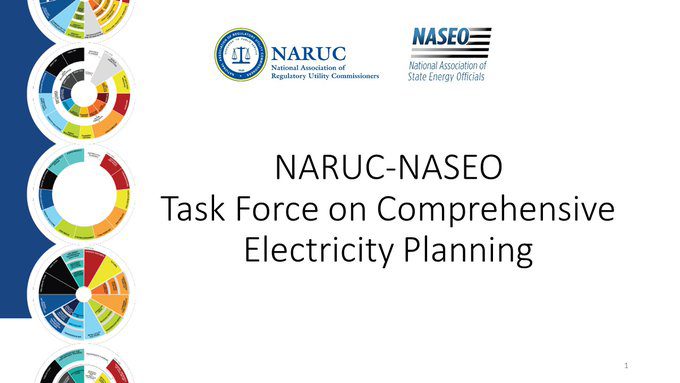Twelve States Announce Action Steps to Plan for Grid of the Future

State Energy Groups Release Blueprint for State Action for a More Efficient, Customer-Centric Grid
WASHINGTON — As part of the conclusion of a national, two-year initiative hosted by the National Association of Regulatory Utility Commissioners and the National Association of State Energy Officials, 12 states made commitments today to implement key innovations to electricity planning in their states to better meet system and customer needs and state policy goals. To advance the state-of-the-art of electricity planning, NARUC and NASEO jointly released a Blueprint for State Action, five Roadmaps for Comprehensive Electricity Planning, an online library and additional resources for states.
The joint NARUC-NASEO initiative — the Task Force on Comprehensive Electricity Planning — presented findings on how states can lead the way in bringing together utilities and stakeholders to plan the grid of the future, impacting how billions of dollars will be invested on behalf of customers. The U.S. Department of Energy provided key support throughout the initiative.
“With utilities making capital expenditures of more than $100 billion per year, it is essential for state decision makers who oversee those investments to consider a broad and robust range of options across the electric system to reliably and affordably meet current and emerging needs, including grid stability, resilience and increased flexibility and optimization for all types of resources,” said Task Force Co-Chair Jennifer Richardson, executive director of the Indiana Office of Energy Development.
Members of the Task Force, established in 2019, are taking steps to apply the principles and strategies they developed — informed by utilities, electricity system stakeholders and technical experts — through concrete actions such as:
- Promoting a more holistic analysis of both distribution and resource system needs and possible solutions (e.g., Arizona, California, Hawaii, North Carolina, Puerto Rico)
- Exploring opportunities to strategically align electricity planning processes to meet state-specific priorities — such as resilience, decarbonization or renewable energy targets —through docketed proceedings or other initiatives (e.g., California, Colorado, Hawaii, Michigan, Minnesota, North Carolina, Rhode Island, Virginia)
- Facilitating the availability of data for improved distribution planning, such as voltage studies, hosting capacity analyses and distributed energy resources siting analyses (e.g., Arkansas, California, Hawaii, Minnesota, Puerto Rico, Rhode Island)
- Holding technical conferences or briefings on Task Force results to support state-specific conversations about opportunities to align planning processes (e.g., Hawaii, Maryland, Minnesota, North Carolina)
- Informing new and existing advisory or working groups to offer dedicated forums for stakeholder input into planning efforts (e.g., Arizona, Hawaii, Maryland)
“The Task Force members worked collaboratively in five teams over two years, representing the diverse regulatory, market and policy structures within which electric utilities operate. Each team outlined an approach for aligning some combination of distribution system, resource and transmission planning processes. It is through such alignment that states will best be able to meet today’s challenges: decarbonization; electrification; and rapidly evolving utility market dynamics,” said Task Force Co-Chair Jeffrey Ackermann, immediate past chairman of the Colorado Public Utilities Commission.
New, more comprehensive approaches to electricity planning can optimize use of distributed and existing energy resources, avoid unnecessary costs to customers, support state policy priorities, and increase transparency of grid-related investment decisions. The Task Force Roadmaps for Comprehensive Electricity Planning are accompanied by a Blueprint for State Action to support states and stakeholders who were not members of the Task Force in aligning electricity system planning processes in ways that meet their own goals and objectives.
“The electric grid is the backbone of our economy and society,” said U.S. Department of Energy’s Acting Under Secretary for Science and Energy Kathleen Hogan. “We continue to strive to gain more value from the grid to meet daily challenges like overcoming the climate crisis, integrating new technologies and meeting the needs of all customers. The suite of resources developed by this Task Force can be used to reimagine a state’s electricity planning processes, and ultimately increase the benefits provided to their consumers.”
To learn more about the Task Force and access the new resources, visit www.naruc.org/taskforce.
###
About NARUC
NARUC is a non-profit organization founded in 1889 whose members include the governmental agencies that are engaged in the regulation of utilities and carriers in the fifty states, the District of Columbia, Puerto Rico and the Virgin Islands. NARUC’s member agencies regulate telecommunications, energy, and water utilities. NARUC represents the interests of state public utility commissions before the three branches of the federal government. www.naruc.org
About NASEO
NASEO is the only national non-profit association for the governor-designated State Energy Directors and the over 3,000 staff of their offices from each of the 56 states and territories. Formed by the states in 1986, NASEO facilitates peer learning among state energy officials, serves as a resource for and about state energy policy, and advocates the interests of the state energy offices to Congress and federal agencies. www.naseo.org


